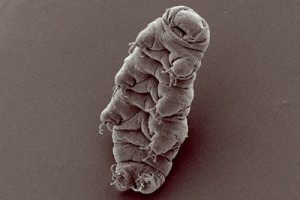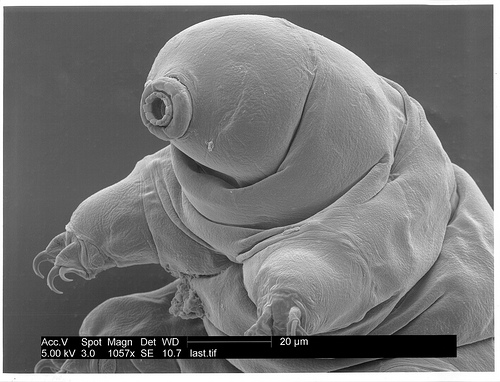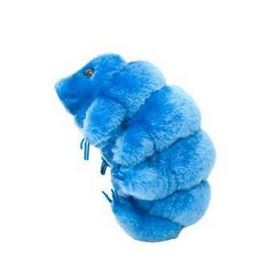Tardigrades: Learning About Water Bears and Resources for Teaching

Tardigrades in Your Own Backyard!
One of my favorite invertebrates is the water bear or tardigrade. It is arguably the most extreme animal on Earth in the unassuming cute and cuddly form of a moss piglet with bear like claws. In this post I'm going to share with you some of the amazing natural history of tardigrades and some teaching resources that you can use for an indoor or outdoor classroom. If you're like me (and love exploring things like this) then you probably will also want to check these cool little guys out at home too, though you'll need a compound microscope to see them.

Tardigrades belong to the phylum Tardigrada. They're aquatic invertebrates commonly found in the base of mosses and lichens; though they can also be found around the world, from the heights if the Himalayas to the depths of hot springs. They are known as extremophiles, meaning that they can live in places on Earth that most creatures couldn't handle. They can endure temperatures of absolute zero, pressure higher than that of the deepest oceans, radiation that would kill all other animals, and they can go without food or water for more than 10 years! Now you'd think a creature that can handle these extremes should be the large and flashy but they're actually not much bigger to 1/2 a millimeter, about the size of the period made by a .5 mm pen.
Water bears look like a caterpillar with four pairs of legs that have curving claws. Their legs aren't jointed so they amble around in a waddling movement, which is why their phylum name literally means "slow-stepper". Usually they are slightly clearish looking but you can also see food pass through their digestive tract when they feed so they may be green, reddish, brown, or blue-green.

Ready for two great new terms that sound like they could be a naturalist's version of an insult? Moss piglets are SUCTORIAL PHYTOPHAGOUS FEEDERS, meaning they eat by sucking the juices of plants such as mosses, lichens, liverworts and algae. They can also eat nematodes (tiny clear worms) and rotifers (clear plankton that live in fresh water). Their mouths have a two sharp stylets in them that they use to pierce the cells of plants and invertebrates. When the water bears molt or shed their exoskeleton the stylets are lost with the shed skin. They secrete a new pair through a pair of glands in their mouth and wallah, instant teeth!
Scientists like tardigrades because they are somewhat like jellyfish but easier to study, find, and culture. Water bears have a clearly defined nervous system and digestive system but they lack a circulatory system and respiratory system; so no breathing or pumping blood. They are also EUTELIC (EWE-Tell-ick) meaning that they have a set number of cells, around 40,000 (I'm sure some poor graduate student had to count these). Tardigrades also have clear male and female sexes. Females lay their eggs in their molted exoskeletons and then the males amble along and fertilize them. Moss piglets are great because they can be cultured in about two weeks, which makes them perfect for a classroom environment or growing your own pets.

As if all this information wasn't enough to make the tardigrade really interesting, they have some crazy adaptations that make them extremophiles. If their little ponds or the water around the base of the mosses where they live dries up then the tardigrades undergo ANHYDROBIOSIS or life without water. Much like the strategy of wood frogs that secrete sugar into their cells to allow them to freeze solid, the water bear also injects sugar into its cells to replace water loss. It then pulls in all its legs, curls into a barrel shape called a 'tun', and enters a death-like state. This can last up to 10 years (but they can also revive with water in about an hour)! Water bears can also enter cryobiosis (dormant state due to cold), osmobiosis (dormant state due to solutes like salt in water), and anoxybiosis (dormant state due to lack of oxygen). The ability to withstand extreme temperature, pressure, radiation, dehydration, toxins and the vacuum of outer space have made water bears highly valued and studied by researchers. They are the only animals proven to survive in space, and they were sent up in the Space Shuttle Endeavour and the Italian STS-134 probe. They were also sent into space by the European Space Agency and given their own space flight program name TARDIS or Tardigrades in Space in 2009.
FINDING TARDIGRADES AND TEACHING WITH THEM
The nice thing about tardigrades is that they make a great classroom teaching subject. They are easy to find, you don't have to order them, you can culture them in about 2 weeks, and you can see them with a compound microscope.
One of the best web resources I've found for curriculum and background materials relating to water bears is the Microbial Life Educational Resources provided by the Science Education Resource Center (SERC) at Carleton College. They have a nice selection of links for lesson plans, anything from freezing tardigrades to free Power Point presentations.
There are quite a few different ways to go about collecting tardigrades depending on the environment you're working in.
Collecting Tardigrades From Mosses
Step 1: Find a nice moist and damp area in your backyard, around a pond, or stream that has mosses. Be sure to collect when the mosses are wet, choose a nice wet day or time of year.
Step 2: Collect a 2-3" square of moss, and try to leave behind as much dirt and debris as possible. Wet the moss with distilled or bottled water, not tap water, Let it soak in about 10 mm of water (1/4") at least half a day or up to 24 hours.
Step 3: Take the moss out of the water and pour the water out. Then squeeze the moss into a separate smaller petri dish or slide that you can observe the water under the microscope.
Step 4: Set aside the moss, re-soak and keep moist. You can then re-inoculate the moss with the water bears or put them on a fresh piece of moss. Feed your water bears regularly with nice moist moss.
If you are interested in collecting tardigrades from lichens, either for experimental comparison or because it's easier for you, then check out the Tardigrade USA website on for a short article, or you can order Mike Shaw's book "How to Find Tardigrades" (very nice reference) on Amazon.com.
For the naturalist in your life you can also order the Tardigrade "Giant Microbe" from Amazon.com. Everyone needs a stuffed tardigrade for their desk!

Tardigrades are amazing creatures, from the tip of their nose to their waddling legs and curvy claws. Their adaptations speak to the wonders of life on Earth and truly amaze and inspire.

